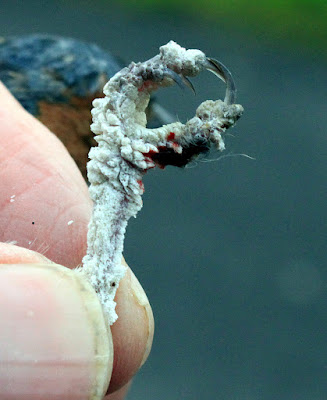The weatherman offered a couple of bright hours before the wind would pick up to make bird ringing impossible. The forecast for weekend looked more dire still, so it was now or never. I decided to head up to Oakenclough for a spot of solo ringing.
There was full cloud throughout together with a cool breeze as the anticipated bright intervals failed to materialise. I ended up with a disappointing 10 birds - 4 Goldfinch, 2 Goldcrest, 2 Blue Tit, plus one each of Coal Tit and Blackcap.
Good numbers of Siskins, 25+, were in evidence again but I failed to catch a single one. Even the normally exuberant Lesser Redpolls stayed out of sight with just a couple of flyovers to note.
The light was so bad this morning I had to shoot birds in the hand at a far from ideal ISO1600.
The Blackcap is a first year female.
Blackcap
The Goldfinch below is a first year undergoing moult transition to a first year female. It is in body moult, hence the feather debris, has replaced the two central tail feathers and is in the process of re-growing the two outermost tail feathers.
Goldfinch
Goldfinch tail
A completely juvenile Goldfinch cannot be sexed until there is some colour around the head. By September a juvenile at this stage could be from a third brood and it is noticeable this week how many Goldfinches are still feeding recently fledged youngsters. The middle picture below was taken on Sunday 6th September.
Goldfinch
Goldfinches
Goldcrest
There didn’t appear to be many Chaffinches around this morning with probably less than 15 seen/heard. The only one caught had a severe case of viral infection to its legs, one leg far worse than the other. The Chaffinch was an adult male and apart from the leg infection seemed in overall good condition, having recently undergone a full moult. It goes without saying I hope that birds displaying any hint of this condition are not given a ring on either leg.
Fringilla papillomavirus
Ringers who catch good numbers of Chaffinches see this disease regularly. It is known as Fringilla papillomavirus (FPV).
The species susceptible to this are Chaffinches and, to a lesser extent, Bramblings. In a large survey of birds captured for ringing in the Netherlands, papillomas were found on 330 (1.3%) of some 25,000 Chaffinches examined and both sexes were affected. However, cases usually occur in clusters and quite high proportions of local populations may be affected in outbreaks. The fact that cases occur in clusters suggests that the presence of affected birds presents a risk to others that are susceptible. The mode of transmission is not known but it seems likely that the virus may be spread via surfaces the birds stand or perch upon.
Even birds with large papillomas often appear to behave normally so, in some cases, the growths may be little more than an inconvenience and relatively minor irritation. However, lameness is sometimes observed.
My own observations over the years suggest that the disease is more prevalent where Chaffinches mix with chickens and wildfowl in both farm and smallholding situations, perhaps even in gamebird rearing situations where feed is either spread upon the ground or spilled via feeding devices.
Even birds with large papillomas often appear to behave normally so, in some cases, the growths may be little more than an inconvenience and relatively minor irritation. However, lameness is sometimes observed.
My own observations over the years suggest that the disease is more prevalent where Chaffinches mix with chickens and wildfowl in both farm and smallholding situations, perhaps even in gamebird rearing situations where feed is either spread upon the ground or spilled via feeding devices.
The morning’s birding was as equally quiet as the ringing - Sparrowhawk, Nuthatch, Grey Wagtail and Great-spotted Woodpecker of note







.JPG)




.JPG)







.jpg)











